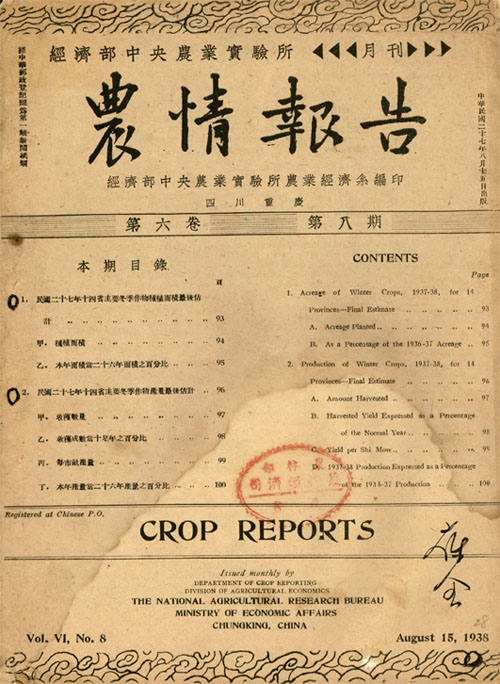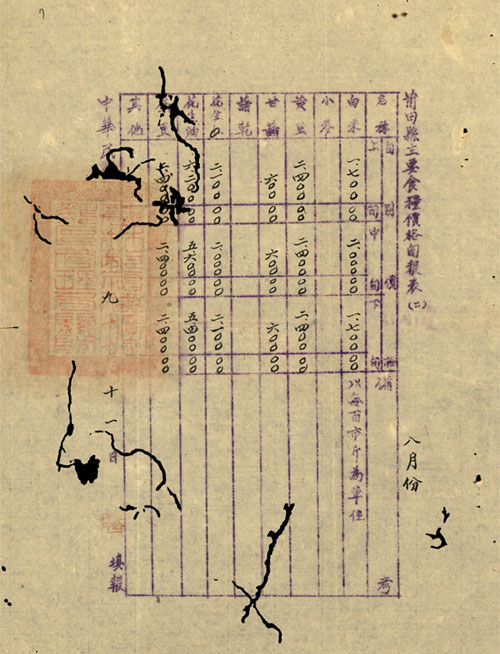Time of announcement: 2023/2/9
Navigating IMH Collections: Reflections of a Doctoral Student
Coleman Mahler (馬克文), PhD Candidate UC Berkeley
After spending close to ten months living and working in Taipei, I flatter myself as possessing at least a passing familiarity with the archival situation in the city, and in Taiwan in general. There are of course a number of major modern historical archives in Taipei itself, including the National Archives (國家檔案局), Academia Historica (國史館) in both its downtown and Xindian branches, and of course, the Academia Sinica Institute of Modern History (IMH, 中研院近史所). Each of these archives has its own particularities: its own rules for how to register and apply for documents; for whether one is allowed to copy or photograph materials, and to what extent; and perhaps most importantly, what kinds of materials are available there. In the rest of this post, I will focus on my experience at IMH in 2022, hopefully providing useful advice on the kinds of materials available, and the research process. My ability to speak to IMH’s collections is of course limited to what I have been researching, and so is only one side of a much larger, more complex picture.
IMH holds collections ranging in date from the late Qing through the KMT’s move to Taiwan, roughly 1840-1970. The specificity of which collections it holds is determined, as far as I understand, by which work units (單位) and individual donors have decided to bequeath their collections to IMH. The National Archives mostly holds materials from the Central Government post-1949, while Academia Historica holds files from the Central and Provincial Government on Taiwan, as well as the Japanese imperial governorship (總督府), and to some extent from the Central Government on the mainland pre-1949. IMH holds a number of collections including: foreign ministry documents dating back to the Qing dynasty; the personal papers of many leaders in the military, politics, finance, and medicine; the files of the Economic (經濟部) and Agricultural (農林部) Ministries of the Republic of China pre-1949; and finally, CCP files captured by the KMT’s intelligence services (調查局) in the 1940s. Within the files of the Economic Ministry are correspondence with and meeting minutes of American-backed organizations on Taiwan in the 1950s-60s, such as the Joint Commission on Rural Reconstruction (JCRR, 農復會) and Economic Stability Board (ESB, 經安會). These were the documents that I primarily worked with.
These wide ranging sources lend themselves to a variety of projects, often in conjunction with research at other archives as well. My dissertation is a history of “official information projects” on Taiwan and the mainland post-1949, with a focus on the production of knowledge of rural society and agriculture for the purpose of economic planning and national construction. I mainly looked at the collections of JCRR, ESB, as well as the Agricultural Ministry. These collections offered far more files than I could possibly view even during my long stay here. They offer a close look into the institutional cultures and changes within these organizations. What they do not do, however, is provide much information about the local level, or the basis for a “history from below.” While this is in no way a critique of the robust sources offered by IMH, it is an important methodological reflection, and is part of a larger lack of such grassroots sources available in major Taiwanese archives in general.
IMH has its own particular means of organizing its collections. There are a few things to know about this. A researcher can find specific files by either using a keyword search, or browsing based on a collection and its sub-headings. The latter can be useful to explore collections and find topics of interest that one might not have known of before. In terms of access, there are a number of kinds of collections, each with different rules about viewing and photography: those that are digitized and available on the main computers, and in theory anywhere in the world with an IMH account (Type 1); the Foreign Ministry collection, which is digitized but mostly available only in the reading room (Type 2); the as-of-yet un-digitized collections, which need to be applied for and read in person (Type 3); and other digitized collections that are available only in the reading room and need to be applied for (Type 4). One thing to note is that although Type 1 collections are in theory viewable anywhere in the world, the image-viewing software that IMH uses is (A) only compatible with Windows and (B) only on specific operating systems, meaning that I personally would not count on being able to view them outside the reading room. This will apparently be changing in the near future with a software overhaul. Type 2 collections can be photographed. Type 3 can be photographed and placed onto a CD-ROM, or with some collections, photocopies made. In general, when the printing/photocopying of a folder is allowed (not always), only 50% of its contents can be printed.
One final thing to note is that the staff at IMH is incredibly helpful and generous. Speaking with them has always been a pleasurable diversion from grinding away at documents, and they have been well prepared and efficient. Additionally, IMH has a vibrant scholarly community, with weekly talks and monthly social gatherings, and visiting scholars are made to feel very welcome.

圖1. 經濟部中央農業實驗所《農情報告》月刊。檔號:18-21-04-025-03,頁3

圖2. 農林部福建省莆田縣《農情報告》。檔號:20-21-009-16,頁7
